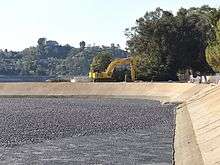Shade balls

Shade balls are small plastic spheres floated on top of a reservoir for environmental protection and to slow evaporation.
Also known as bird balls, they were developed initially to prevent birds from landing on toxic tailing ponds produced by mining operations.[1] They have been used by airports to prevent birds from being attracted to drainage ponds and thus risking collisions with planes.[2]
Usage by LADWP

Starting in mid-2008, the Los Angeles Department of Water and Power deployed about 400,000 of these devices in the Ivanhoe reservoir with the main objective of preventing the formation of a carcinogenic chemical, bromate, which forms when naturally occurring bromine reacts with chlorine in the presence of sunlight.[1][3] In the original release by the LADWP, there is no mention of water conservation as an objective, and the project was planned for a five year life span, until a Griffith Park project was completed. However, the reduction in evaporation led to a saving of more than a billion gallons of water in one year.[1]
In 2014 and 2015, the LADWP deployed 96 million shade balls on its largest reservoir in response to the United States Environmental Protection Agency's surface water treatment rule,[4] which requires large reservoirs to be covered.[5][6] The LADWP claims that in addition to reducing evaporation, they will also reduce UV radiation by-products and algae growth.[7]
Construction
The shade balls used in the Los Angeles project are made of high-density polyethylene (HDPE) with carbon black additive to protect the plastic from ultraviolet radiation. Adding carbon black also prevents the formation of bromate, which causes stomach problems when water contaminated with it is consumed.[8][9][10][11]
They are about 4 inches (10 cm) in diameter, and partially filled with water to avoid being blown by wind. HDPE plastic is commonly used for food and beverage containers as well as water distribution pipes.[8]
References
- 1 2 3 "SHADE BALLS – JUST ADD WATER". Toronto Star, October 23, 2016 Marco Chown Oved
- ↑ Los Angeles Unleashes 'Shade Balls' To Protect Reservoir Water Quality
- ↑ Vara-Orta, Francisco. "A reservoir goes undercover". Los Angeles Times. Los Angeles Times. Retrieved 27 December 2015.
- ↑ "Water: Long Term 2 Enhanced Surface Water Treatment Rule". United States Environmental Protection Agency. 2013-02-11. Retrieved 2015-08-13.
- ↑ "Los Angeles Unleashes 'Shade Balls' To Protect Reservoir Water Quality". National Public Radio. 2015-08-12. Retrieved 2015-08-13.
- ↑ Walton, Alice; Grad, Shelby (2015-08-12). "The 36-cent 'shade ball' that could save $250 million and keep L.A. water clean". The Los Angeles Times. Los Angeles: The Los Angeles Times. Retrieved 2015-08-12.
Shade balls are used to protect water quality, prevent algae growth and slow evaporation from the city’s reservoirs.
- ↑ Walton, Alice (August 23, 2015). "L.A.'s shade balls go viral — but the Internet has mixed opinion". Los Angeles Times. Retrieved 24 August 2015.
- 1 2 "Shade Balls: Sustainable Drought Prevention", retrieved 3-31-2016, Precision Plastic Ball
- ↑ "Los Angeles Reservoir Covered With 96 Million Shade Balls to Conserve Water Amidst Drought" (Aug 12, 2015) ABC News
- ↑ "'Shade balls' protect LA water supply during drought" (13 Aug 2015) CNBC
- ↑ "LA Rolls Out Water-Saving 'Shade Balls'" (August 11, 2015) NPR
External links
| Wikimedia Commons has media related to Shade balls. |
Coordinates: 34°06′14″N 118°15′59″W / 34.1040°N 118.2663°W